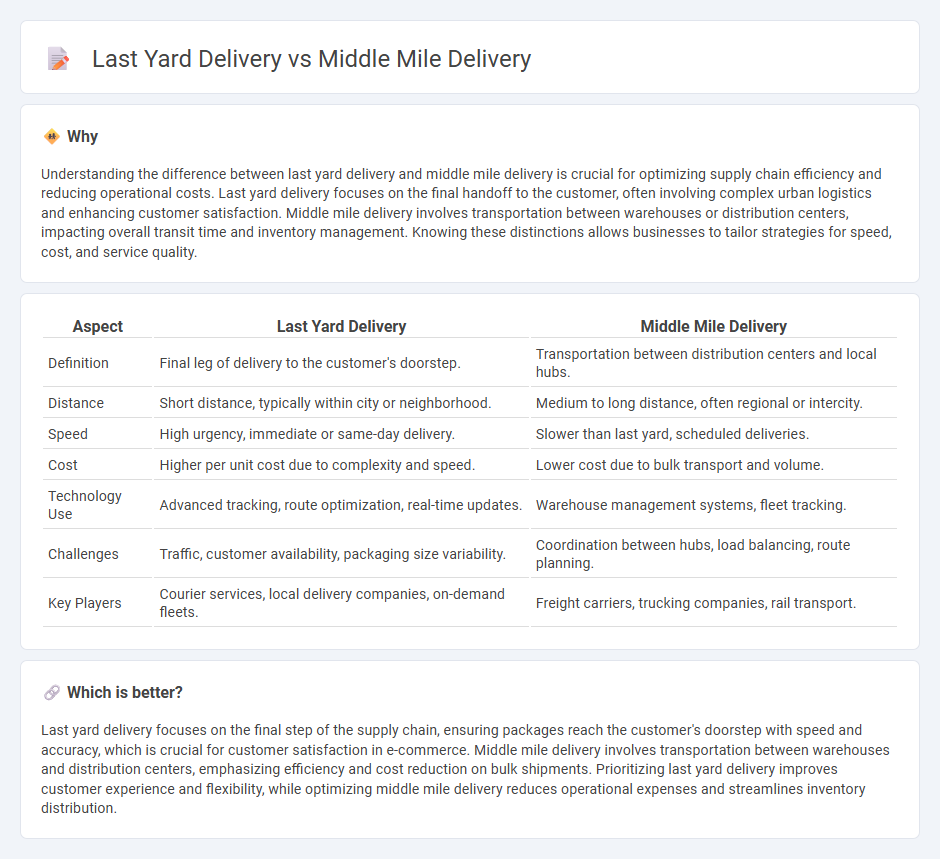
Last yard delivery focuses on transporting goods from a local distribution center directly to the final customer, emphasizing speed and precision in urban environments. Middle mile delivery covers the movement of goods between warehouses and retail hubs, optimizing bulk transportation over longer distances. Discover how these integral segments of logistics streamline supply chains and enhance customer satisfaction.
Why it is important
Understanding the difference between last yard delivery and middle mile delivery is crucial for optimizing supply chain efficiency and reducing operational costs. Last yard delivery focuses on the final handoff to the customer, often involving complex urban logistics and enhancing customer satisfaction. Middle mile delivery involves transportation between warehouses or distribution centers, impacting overall transit time and inventory management. Knowing these distinctions allows businesses to tailor strategies for speed, cost, and service quality.
Comparison Table
| Aspect | Last Yard Delivery | Middle Mile Delivery |
|---|---|---|
| Definition | Final leg of delivery to the customer's doorstep. | Transportation between distribution centers and local hubs. |
| Distance | Short distance, typically within city or neighborhood. | Medium to long distance, often regional or intercity. |
| Speed | High urgency, immediate or same-day delivery. | Slower than last yard, scheduled deliveries. |
| Cost | Higher per unit cost due to complexity and speed. | Lower cost due to bulk transport and volume. |
| Technology Use | Advanced tracking, route optimization, real-time updates. | Warehouse management systems, fleet tracking. |
| Challenges | Traffic, customer availability, packaging size variability. | Coordination between hubs, load balancing, route planning. |
| Key Players | Courier services, local delivery companies, on-demand fleets. | Freight carriers, trucking companies, rail transport. |
Which is better?
Last yard delivery focuses on the final step of the supply chain, ensuring packages reach the customer's doorstep with speed and accuracy, which is crucial for customer satisfaction in e-commerce. Middle mile delivery involves transportation between warehouses and distribution centers, emphasizing efficiency and cost reduction on bulk shipments. Prioritizing last yard delivery improves customer experience and flexibility, while optimizing middle mile delivery reduces operational expenses and streamlines inventory distribution.
Connection
Last yard delivery and middle mile delivery are interconnected components of the supply chain, where middle mile delivery involves transporting goods from warehouses or distribution centers to local hubs closer to the final destination. Efficient middle mile delivery ensures timely and accurate inventory availability for last yard delivery, which focuses on the final step of delivering packages directly to consumers. Optimizing this connection reduces transit times, lowers operational costs, and enhances overall delivery performance in logistics networks.
Key Terms
**Middle Mile Delivery:**
Middle Mile Delivery involves the transportation of goods from a manufacturer or warehouse to a distribution center, covering a crucial segment in the supply chain that often spans long distances and uses freight carriers, trucks, or rail. This stage focuses on efficiency, cost reduction, and timely transfer to optimize inventory flow before the last mile delivery phase. Explore more to understand how middle mile logistics enhance overall delivery performance and reduce operational costs.
Distribution Center
Middle mile delivery involves transporting goods from distribution centers to local hubs or regional warehouses, optimizing bulk movement and route efficiency. Last yard delivery focuses on the final leg, ensuring shipments reach the customer's doorstep with precision and speed. Explore the key differences and strategies to enhance your distribution center operations.
Line Haul
Line haul in middle mile delivery involves transporting bulk shipments between warehouses or distribution centers using trucks, trains, or freight carriers, optimizing route efficiency and volume handling capacity. Last yard delivery focuses on the final segment, from the local hub to the customer's doorstep, where smaller vehicles and rapid delivery methods ensure timely fulfillment. Explore our detailed comparison to understand how line haul impacts overall supply chain performance.
Source and External Links
What is Middle Mile Delivery or Second Mile Delivery? - Middle mile delivery refers to the transport of goods from a warehouse or distribution center to fulfillment facilities, serving as a cost-efficient crucial link in the supply chain before last-mile delivery to customers.
Understanding First Mile, Middle Mile, and Last Mile Logistics - The middle mile involves bulk shipments moving goods from warehouses or local centers to regional distribution centers, requiring strategic planning and multimodal transport to ensure smooth and cost-effective supply chain flow.
What is the Middle Mile in Logistics? - Middle mile delivery moves goods from ports or factories to fulfillment centers, distinct from last mile delivery, leveraging technology and third-party logistics providers to maximize efficiency and reduce costs.
 dowidth.com
dowidth.com